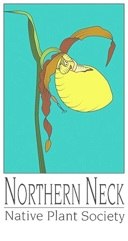GO NATIVE GROW NATIVE DEMO GARDEN at INDIAN CREEK YACHT & COUNTRY CLUB
In late afternoon of Thursday, August 30, 2018, Beth Kendrick and I planted a Goldenclub in the pond off the 12th hole at ICYCC. Goldenclub [Orontium aquaticum] is one of the Northern Neck’s quirky native plants that in my travels, I have not seen growing. It was first shown to me by Bill Portlock of Chesapeake Bay Foundation at our wetlands training session for Virginia Master Naturalist basic training. His sample had come from a private pond closer to Rt. 301. When the NNNPS sponsored a field trip to Meadowview Biological Station, managed by Dr. Phil Sheridan in Woodford, VA last May, I was able to purchase a specimen there with the intent of giving it a home at the wetland demo garden at ICYCC.The baby plant was placed in shallow water of the pond near the outflow to provide some water flow. I fluffed its roots into the soft mud and encircled it with a hardware cage about three feet diameter and one foot high, then staked the cage to keep all in place. Our hope is that this will enable it to grow, spread and provide future plants in an environment we can monitor. If you go looking for it, be sure to watch out for golfers and wear waterproof footwear. It is in the pond to the left of the tee.
wikipedia commons
wikipedia
Both pictures are showing the plant on left as it looks now but in Spring bloom, and on right, what we are hoping for!
Go see this demo garden! We walked around the main demo garden to the right of the tee marveling at the display of Cardinal Flower Lobelia cardinalis, Blue Lobelia Lobelia syphilitica, Meadow Beauty Rhexia virginica, Mistflower Conoclinium coelestinum, New York Ironweed Vernonia noveboracensis, Brown-eyed Susan Rudbeckia triloba, Seashore Mallow Kosteletzkya pentacarpos, and the many varieties of sedges. There was much activity with dragonflies of several colors eating mosquitos, butterflies nectaring, frogs squeaking at our passage and a great blue heron posing in the shallows. We chuckled at the peculiar fruiting bodies of the Buttonbush Cehpalanthus occidentalis, reportedly eaten by “water and shorebirds”. Beth told me that Redwing Blackbirds nested in among the cattails this season. She keeps an eye on the garden when she plays through…
Paula Boundry


